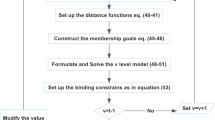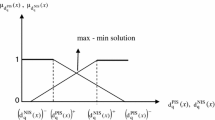Abstract
Despite the important role of bi-level multi-objective linear fractional programming (BL-MOLFP) problem for many hierarchical organizations, a very little success has been achieved to deal with this problem. This paper presents a comparative study between two computational approaches, namely fuzzy TOPSIS (technique for order preference by similarity to ideal solution) approach and Jaya (a Sanskrit word meaning victory) approach, for solving BL-MOLFP problem. The fuzzy TOPSIS (FTOPSIS) approach aims to obtain the satisfactory solution of BL-MOLFP problem by using linearization process as well as formulating the membership functions for the distances of positive ideal solution (PIS) and negative ideal solution (NIS) for each level, respectively. In this sense, the deadlock situations among levels are avoided by establishing the membership functions for the upper level decision variables vector with possible tolerances. On the other hand, Jaya algorithm is proposed for solving BL-MOLFP problem based on nested structure scheme to optimize both levels hierarchically. An illustrative example is presented to describe the proposed approaches. In addition, the performances among the proposed approaches are assessed based on ranking strategy of the alternatives to affirm the superior approach. Based on the examined simulation, Jaya algorithm is preferable than the FTOPSIS approach.




Similar content being viewed by others

Abbreviations
- BL-MOLFP:
-
Bi-level multi-objective linear fractional programming
- TOPSIS:
-
Technique for order preference by similarity to ideal solution
- FTOPSIS:
-
Fuzzy TOPSIS
- PIS:
-
Positive ideal solution
- NIS:
-
Negative ideal solution
- MLPP:
-
Multi-level programming problem
- BLPP:
-
Bi-level programming problem
- FGP:
-
Fuzzy goal programming
- MCDM:
-
Multiple criteria decision making
- MOLFP:
-
Multi-objective linear fractional programming
- LP:
-
Linear programming
- LFP:
-
Linear fractional programming
- SCCFP:
-
Standard concave-convex fractional programming
- QFP:
-
Quadratic fractional programming
- ULDM:
-
Upper-level decision maker
- LLDM:
-
Lower- level decision maker
- DMs:
-
Decision makers
- MODM:
-
Multi-objective decision making
- \(K\) :
-
No. of objectives (criteria)
- \(G_{1} ,\,G_{2}\) :
-
The feasible regions of the upper and the lower level decision makers
- \(n\) :
-
Number of control variables
- \(q\) :
-
Number of constraints
- \(F(x)\) :
-
Vector of objective functions
- \(F_{{}}^{*}\) :
-
Reference point or ideal point or PIS
- \(F^{ - }\) :
-
Nadir point or anti-ideal point or NIS
- \(\lambda_{j}\) :
-
Relative significance (weights) of objectives
- \(\mu_{1} ,\,\mu_{2}\) :
-
The membership functions of the two objective functions
- \({\mathbf{x}}_{{\mathbf{1}}}\) :
-
Control vector of the upper-level DM
- \({\mathbf{x}}_{{\mathbf{2}}}\) :
-
Control vector of the lower-level DM
- \(\alpha ,\,\delta\) :
-
The satisfactory levels
- \(f({\varvec{x}})\) :
-
The objective function to be minimized (or maximized)
- PS:
-
Population size
References
Anuradha, G., Arora, S.R.: Multi-Level multi-Objective integer linear programming problem. Advanced Modeling and Optimization 10(2), 297–322 (2008)
Sakawa, M., Nishizaki, I.: Interactive fuzzy programming for multi-level programming problems: a review. International Journal of Multicriteria Decision Making 2(3), 241–266 (2012)
Abo-Sinna, M.A.: A Bi-level non-linear multi-objective decision making under fuzziness. OPSEARCH 38(5), 484–495 (2001)
Arora, S.R., Gupta, R.: Interactive fuzzy goal programming approach for bilevel programming problem. Eur. J. Oper. Res. 194, 368–376 (2009)
Zheng, Y., Liu, J., Wan, Z.: Interactive fuzzy decision making method for solving bilevel programming problem. Appl. Math. Model. 38(13), 3136–3141 (2014)
Baky, I.A., Abo-Sinna, M.A.: TOPSIS for bi-level MODM problems. Appl. Math. Model. 37, 1004–1015 (2013)
Bard, J.F.: Practical Bi-level Optimization: Algorithm and Application. Kluwer Academic Publisher, The Netherlands, USA (1998)
Lai, Y.J.: Hierarchical optimization: a satisfactory solution. Fuzzy Sets Syst 77, 321–335 (1996)
Shih, H.S., Lai, Y.J., Lee, E.S.: Fuzzy approach for multi-level programming problems. Comput. Oper. Res 23(1), 773–791 (1983)
Sinha, S.: Fuzzy mathematical approach to multi-level programming problems. Comput. Oper. Res 30, 1259–1268 (2003)
Mohamed, R.H.: The relationship between goal programming and fuzzy programming. Fuzzy Sets Syst 89, 215–222 (1997)
Pal, B.B., Moitra, B.N.: A fuzzy goal programming procedure for solving quadratic bilevel programming problems. Int. J. Intell. Syst 18(5), 529–540 (2003)
Pramanik, S., Roy, T.K.: Fuzzy goal programming approach to multi-level programming problems. Eur. J. Oper. Res 176, 1151–1166 (2007)
Baky, I.A.: Solving multi-level multi-objective linear programming problems through fuzzy goal programming approach. Appl. Math. Modell 34, 2377–2387 (2010)
Abo-Sinna, M.A., Baky, I.A.: Interactive balance space approach for solving multi-level multi-objective programming problems. Inf. Sci 177, 3397–3410 (2007)
Lachhwani, K.: On solving multi-level multi objective linear fractional programming problems through fuzzy goal programming approach. J. Oper.Res.Soc. India, OPSEARCH 51 (4), 624–637(2014)
Ren, A.: Solving the General Fuzzy Random Bilevel Programming Problem Through Me Measure-Based Approach. IEEE Access 6, 25610–25620 (2018)
Kuo, R.J., Han, Y.S.: A hybrid of genetic algorithm and particle swarm optimization for solving bi-level linear programming problem–A case study on supply chain model. Appl. Math. Model. 35(8), 3905–3917 (2011)
Zhang, T., Chen, Z., Zheng, Y., Chen, J.: An improved simulated annealing algorithm for bilevel multiobjective programming problems with application. J. Nonlinear Sci. Appl. 9(6), 3672–3685 (2016)
Wu, S., Chen, S.: A Bi-level algorithm for product line design and pricing. In 2014 IEEE International Conference on Industrial Engineering and Engineering Management, 14–18 (2014)
Eichfelder, G.: Multiobjective bilevel optimization. Math. Program. 123(2), 419–449 (2010)
Kalashnikov, V.V., Dempe, S., Pérez-Valdés, G.A., Kalashnykova, N.I., Camacho-Vallejo, J.F.: Bilevel programming and applications. Math. Prob. Eng. 2015, 1–16 (2014)
Emam, O.E.: Interactive approach to bi-level integer multi-objective fractional programming problem. Appl. Math. Comput. 223, 17–24 (2013)
Bellmann, R.E.: Dynamic Programming. Princeton University Press, Princeton, NJ (1957)
Osman, M.S., Emam, O.E., Raslan, K.R., Farahat, A.F.: Solving bi-level multi objective quadratic fractional programming problems in rough environment through FGP approach. J. Abstract Comput. Math. 3(1), 6–21 (2018)
Saraj, M., Safaei, N.: Fuzzy Linear Fractional Bi-Level Multi-Objective Programming Problems. Int. J. Appl. Math. Res. 1(4), 643–658 (2012)
Youness, E.A., Emam, O.E., Hafez, M.S.: Fuzzy Bi-Level Multi-Objective Fractional Integer Programming. Appl. Math. Inf. Sci. 8(6), 2857–2863 (2014)
Dey, P.P., Pramanik, S., Giri, B.C.: TOPSIS approach to linear fractional bi-level MODM problem based on fuzzy goal programming. J Ind Eng Int 10, 173–184 (2014)
Hwang, C.L., Yoon, K.: Multiple attribute decision making: methods and applications. Springer-Verlag, Heidelberg (1981)
Tirkolaee, E.B., Mardani, A., Dashtian, Z., Soltani, M., Weber, G.W.: A novel hybrid method using fuzzy decision making and multi-objective programming for sustainable-reliable supplier selection in two-echelon supply chain design. J. Cleaner Prod. 250, 119517 (2020). https://doi.org/10.1016/j.jclepro.2019.119517
Tirkolaee, E.B., Goli, A., Faridnia, A., Soltani, M., Weber, G.W.: Multi-Objective Optimization for the Reliable Pollution-Routing Problem with Cross-Dock Selection using Pareto-based Algorithms. J. Cleaner Prod. 276, 122927 (2020). https://doi.org/10.1016/j.jclepro.2020.122927
Abo-Sinna, M.A., Amer, A.H.: Extensions of TOPSIS for multiobjective large-scale nonlinear programming problems. Appl. Math. Comput. 162, 243–256 (2000)
Abo-Sinna, M.A., Amer, A.H., Ibrahim, A.S.: Extensions of TOPSIS for large scale multi-objective non-linear programming problems with block angular structure. Appl. Math. Model. 32, 292–302 (2008)
Rizk-Allah, R.M., Zaki, E.M., El-Sawy, A.A.: Hybridizing ant colony optimization with firefly algorithm for unconstrained optimization problems. Appl. Math. Comput. 224, 473–483 (2013)
Rizk-Allah, R.M., El-Sehiemy, R.A., Wang, G.G.: A novel parallel hurricane optimization algorithm for secure emission/economic load dispatch solution. Appl. Soft Comput. 63, 206–222 (2018)
Rizk-Allah, R.M.: Hybridizing sine cosine algorithm with multi-orthogonal search strategy for engineering design problems. J. Comput. Des. Eng. 5, 249–273 (2018)
Rizk-Allah, R.M., Hassanien, A.E.: New binary bat algorithm for solving 0–1 knapsack problem. Comp. Int. Syst. 4(1), 31–53 (2018)
Rizk-Allah, R.M., Hassanien, A.E., Bhattacharyya, S.: Chaotic Crow Search Algorithm for Fractional Optimization Problems. Appl. Soft Comput. 71, 1161–1175 (2018)
Tirkolaee, E.B., Goli, A., Weber, G.W.: Fuzzy Mathematical Programming and Self-Adaptive Artificial Fish Swarm Algorithm for Just-in-Time Energy-Aware Flow Shop Scheduling Problem with Outsourcing Option. IEEE Transactions on Fuzzy Systems (2020). https://doi.org/10.1109/TFUZZ.2020.2998174
Deb, K., Sinha, A.: Constructing test problems for bilevel evolutionary multiobjective optimization. IEEE Congress on Evolutionary Computation,1153–1160 (2009)
Deb, K., Sinha, A.: Solving bilevel multiobjective optimization problems using evolutionary algorithms. Lect. Notes Comput. Sci. Evolut. Multi-Criterion Optim. 5467, 110–124 (2009a)
Deb, K., Sinha, A.: An evolutionary approach for bilevel multiobjective problems. Commun. Comput. Inf. Sci. 35, 17–24 (2009b)
Rizk-Allah, R.M., Abo-Sinna, M.A.: Integrating reference point, Kuhn-Tucker conditions and neural network approach for multi-objective and multi-level programming problems. OPSEARCH 54, 663–683 (2017)
Rao, R.: Jaya: A simple and new optimization algorithm for solving constrained and unconstrained optimization problems. Int. J. Ind. Eng. Comput. 7, 19–34 (2016)
Warid, W., Hashim, H., Norman, M., Noor, I.A.W.: A novel quasi-oppositional modified Jaya algorithm for multi-objective optimal power flow solution. Appl. Soft Comput. 65, 360–373 (2018)
Buddala, R., Mahapatra, S.S.: Improved teaching–learning based and JAYA optimization algorithms for solving flexible flow shop scheduling problems. J. Ind. Eng. Int. 14, 555–570 (2017)
Rao, R.V., Saroj, A.: Constrained economic optimization of shell-and-tube heat exchangers using elitist-Jaya algorithm. Energy 128, 785–800 (2017)
Charnes, A., Cooper, W.W.: Programming with Linear Fractional Functionals. Naval Res. Logis. Quart. 9, 181–186 (1962)
Veeramani, C., Sumathi, M.: Fuzzy Mathematical Programming approach for Solving Fuzzy Linear Fractional Programming Problem. RAIRO-Oper. Res. 48(1), 109–122 (2014)
Singh, S.K., Yadav, S.P.: Fuzzy Programming Approach for Solving Intuitionistic Fuzzy Linear Fractional Programming Problem. Int. J. Fuzzy Syst. 18(2), 263–269 (2016)
Chakraborty, M., Gupta, S.: Fuzzy mathematical programming for multi objective linear fractional programming problem. Fuzzy Sets Syst. 125(3), 335–342 (2002)
Mishra, S., Ghosh, A.: Interactive fuzzy programming approach to Bi-level quadratic fractional programming problems. Ann. Oper. Res. 143(1), 251–263 (2006)
Baky, I.A.: Fuzzy goal programming algorithm for solving decentralized bilevel multiobjective programming problems. Fuzzy Sets Syst. 160, 2701–2710 (2009)
Lai, Y.J., Liu, T.J., Hwang, C.L.: TOPSIS for MODM. Euro. J. Oper. Res. 76, 486–500 (1994)
Bellman, R.E., Zadeh, L.A.: Decision-making in a fuzzy environment. Manag. Sci. 17, 141–164 (1970)
Zimmermann, H.J.: Fuzzy Sets, Decision Making, and Expert Systems. Kluwer Academic, Boston (1987)
Socorro, Lamata: On rank reversal and TOPSIS method. Math. Comput. Modell. 56(5–6), 123–132 (2012)
Acknowledgements
The authors express their gratitude to the editor and the anonymous reviewers for their insightful and constructive suggestions to improve the quality of this paper. First author is very thankful to her beloved wife Mariam Sabry for their endless support to throughout the writing of this paper
Funding
Not applicable.
Author information
Authors and Affiliations
Contributions
RM designed the algorithm, implemented all experiments, wrote the manuscript, and finalized the manuscript.
MA revised the manuscript.
Corresponding author
Ethics declarations
Ethics approval and consent to participate
Not applicable.
Consent for publication
Not Applicable.
Availability of data and material
Not applicable.
Competing interests
The authors declare that they have no competing interests.
Additional information
Publisher's Note
Springer Nature remains neutral with regard to jurisdictional claims in published maps and institutional affiliations.
Rights and permissions
About this article
Cite this article
Rizk-Allah, R.M., Abo-Sinna, M.A. A comparative study of two optimization approaches for solving bi-level multi-objective linear fractional programming problem. OPSEARCH 58, 374–402 (2021). https://doi.org/10.1007/s12597-020-00486-1
Accepted:
Published:
Issue Date:
DOI: https://doi.org/10.1007/s12597-020-00486-1



